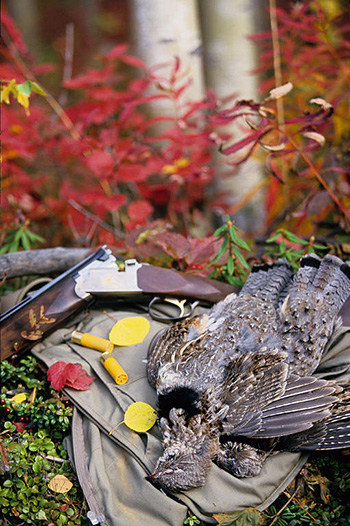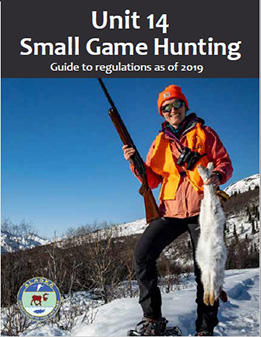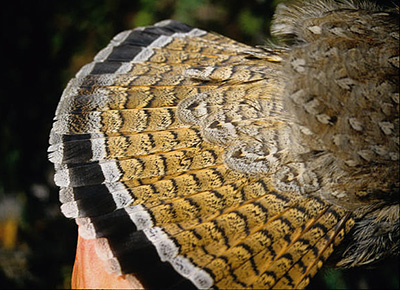Alaska Fish & Wildlife News
August 2019
Bird Hunting and Sharing a Wing and a Tail
New Guide Highlights Small Game Hunting

Hard to believe, but another summer is slipping away and ushering in cooler temperatures and a long list of chores that remain undone. Summers in Alaska seem to move at a pace that far outruns any other season. However, don’t be forlorn. One of the best times of the year is upon us. The end of tourist and construction season is fast approaching and soon leaves will begin to turn a fiery yellow and sift down from the tree tops. It will soon be time to continue ignoring the long list of chores, put the fishing rods away, and dust off the shotgun and rifle. Hunting seasons are opening in Alaska from caribou and sheep to grouse and ptarmigan.
Despite the big game hunting bouquet of opportunities in Alaska, I still love to get out and walk the woods and alpine ridges with my 20-gauge this time of year, hunting for Alaska’s abundant and diverse collection of grouse and ptarmigan, particularly here in Southcentral Alaska. Despite the largest urban area in Alaska, which more than half of the residents of Alaska call home, Southcentral Alaska has some fantastic upland bird and snowshoe hare hunting opportunities if you’re interested. The cities of Anchorage, Eagle River, Palmer, Wasilla, Willow, and Talkeetna sit in what is known as Game Management Unit (Unit) 14, according to Alaska Department of Fish and Game regulations. Unit 14 is further subdivided into three subunits. Subunit 14A encompasses the area and communities near Palmer and Wasilla, subunit 14B, the areas north of Willow to Talkeetna and east of the Susitna River. Finally subunit 14C, is the area otherwise known as the “Anchorage Bowl” including Birchwood, Eagle River, Anchorage, and south to Girdwood and Portage.

Regulations in subunit 14C (“Anchorage Bowl”) are of particular interest to many small game hunters. It is often the closest place for many to hunt but regrettably it has also become known as the most complex area of the state to interpret the small game hunting regulations. As a result of the high human density, suburban sprawl, popular hiking and dog walking trails, mountain biking, berry picking, and just general outdoor recreational opportunities the regulations have become very complex. As a result, the ADF&G has embarked on what has turned out to be a two-year project to create a handout to help interpret these regulations for those interested in small game hunting in Unit 14, with specific emphasis on subunit 14C.
Some of the biggest challenges facing hunters in Alaska are understanding regulations and landownership in the specific area in which they’d like to hunt. In Unit 14 and specifically in subunit 14C this can be particularly challenging. This handout breaks down the small game hunting regulations in an easy to understand, map-based format. It highlights the specific Managements Areas, inside which are further restricted besides the general subunit regulations. Although landownership is an ever moving target this handout provides contact information for the primary landowners in Unit 14. It was designed for the hunter in mind, coming in a small, foldable size so that it can easily fit into a backpack, glove box, or field vest. This handout will be free and available at the Anchorage and Palmer ADF&G offices. Stop by and pick up a copy or two for yourself this hunting season and enjoy getting out small game hunting in Unit 14.

In addition to the new Unit 14 Small Game Hunting Regulation handout, the ADF&G also has other helpful resources for the avid small game hunter this season. These include: 1) the age and sex guide to help hunters determine the age and sex of their upland bird harvest, 2) Alaskans Afield classes offered in Palmer and Anchorage (among other statewide locations) regarding small game hunting in Alaska, and 3) free wing envelopes for hunters interested in contributing their harvest to allow biologists to better understand statewide harvest composition of grouse and ptarmigan. Links to these resources can be found at ADF&G’s home page or www.smallgame.adfg.alaska.gov.

The statewide wing collection project has been particularly helpful for biologists to better understand and estimate harvest composition of grouse and ptarmigan as well as estimating population productivity (chick survival) from the previous breeding season. Since the project was formally implemented statewide (August 2011) the statewide Small Game Program (SGP) has received nearly 9,000 wings from all seven Alaskan grouse and ptarmigan species from nearly 250 hunters statewide. Samples have been received from Utqiagvik to Ketchikan and everywhere in between. Among many other things hunters may be interested to know that spruce grouse and willow ptarmigan are the most heavily hunted and harvested upland bird species in Alaska every year.

Participating in the statewide wing collection program is very easy and free. Free wing envelopes can be picked up at most ADF&G offices around the state or by contacting SGP staff directly (Cameron Carroll-907.459.7237 or Rick Merizon-907.746.6333). Simply collect one clean wing and tail from each harvested grouse or one clean wing and head from each harvested ptarmigan and enclose individual samples per envelope. Either drop off the envelope at your local ADF&G office or send them directly to SGP staff in Fairbanks or Palmer.
With some new and some long standing small game hunting resources available this year I hope you’re able to get out, enjoy the sights, smells, and scenery of what will be another beautiful fall in Alaska. I for one am planning to get out into the forests and alpine ridges in pursuit of Alaska’s abundant and diverse small game opportunities. You might even catch me hiking through some fantastic grouse and ptarmigan habitat, 20-gauge in hand, in Unit 14 this fall.
Wildlife Biologist Rick Merizon is the coordinator of the ADF&G small game program, which includes research and management of hares, grouse and ptarmigan in Alaska.
Subscribe to be notified about new issues
Receive a monthly notice about new issues and articles.
